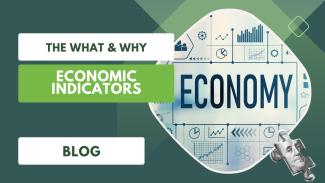
Economic Indicators: What & Why
Economic Indicators: What and Why
The economy is always top of mind for news outlets but over the last few years, it’s rare to go even a day without your favorite news outlet discussing the primary economic indicators. In this blog, we’re breaking down the key indicators so you can better understand what they are and why they are important. Economic indicators are statistics used by economists to analyze economic performance and predict future performance. These indicators allow economists to try and determine the future outcome for an economy and help stabilize and grow from previous years. There are many economic indicators from how productive an economy is, to the stability of the housing market, and even how much consumers are willing to spend on items. Here are some of the more important economic indicators to look out for:
- Gross Domestic Product (GDP) - GDP is one of the most important and most well-known indicator economists use when looking at an economy. It provides the overall value of an economy which indicates if the economy is growing or slowing. It is broken into different segments: Consumption, Investment, Government spending, and Net exports. GDP is also the indicator to determine if a country is in a recession, as a recession occurs when there are two consecutive quarters of negative GDP growth.
- CPI/PPI - Inflation is seen as the general price level rise that goods or services have in an economy. Inflation is not always a bad thing. Inflation can be a sign of a growing economy, but it hurts the purchasing power of consumers. A few reports that help track inflation are the Consumer Price Index (CPI), the wholesale Price Index (WPI), and the Producer Price Index (PPI).
- New & Existing Home Sales – As the housing market is increasing year after year the Existing Home Sales report is a great indicator in determining which direction the housing market is going. The Census Bureau puts out the monthly report on the number of contracts to buy new single-family homes and the National Association of Realtors provides sales and prices for existing single-family homes.
- Manufacturing PMI - The Manufacturing Purchasing Managers Index (PMI) reports on shipment, inventories, and orders. These metrics can help determine how much demand there is for a certain product. The Institute for Supply Management (ISM) reports these metrics monthly and breakdown the items by industry so you can determine the demand for these items and see if a specific industry is expanding or slowing down.
- Nonfarm Payrolls/Unemployment Rate - The Bureau of Labor Statistics releases a monthly report on the total nonfarm payroll employment and the unemployment rate. The nonfarm payroll employment measures the change in the number of people employed during the previous month, excluding jobs in the farming industry. The unemployment rate is the number of people unemployed as a percentage of the number of people in the labor force. These statistics can help determine how difficult it may be to find a job in a certain industry as the unemployment rate only considers people who do not have a job but have been actively looking for the past four weeks.
These are just a few of the important economic indicators that investors can look at if you are trying to determine the stability of the economy, the security of your job, or the growth of your investments. It’s our philosophy at Crosby Advisory Group to give our clients the tools so they can understand what is impacting their wealth strategy. If you have questions on economic indicators and their role in your achieving your goals, don’t hesitate to give our office a call.
Disclaimer: Crosby Advisory Group, LLC provides financial planning, business growth strategies and Insurance protection. CAG is a registered investment advisor. Investing involves risk including the potential loss of principal. Consider all risks before investing.

